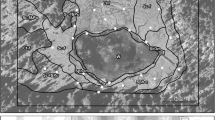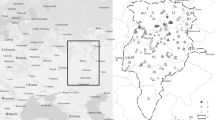Abstract
Chemical variables, algae, bryophytes, and vascular plants were determined in twelve mires located in the plateau of the Sierra Segundera range. All the mires studied are minetrophic in relation to water origin, and oligotrophic poor fens in relation to water chemistry. They were classified into two types: (a) `slope mires', developed in effluent basins or depressions on slopes, usually small in size and poorly developed, and (b) `basin mires', formed in closed basins, more developed than the previous type, always including hummocks and hollows, and in some cases sedge swamps in the ponds margins.The Sierra Segundera mire system is one of the better conserved mire complexes in the Iberian Peninsula. Bryophyte and vascular plant communities were similar to those in central and northern Europe, although some Mediterranean taxa tolerating water level variation also exist. Diatomaceae were scarce whilst Cyanophyta were relatively common, which differentiate those mires from northern European ones.
Similar content being viewed by others
References
Aldasoro, J. J., C. Aedo, J. Muñoz, C. de Hoyos, J. C. Vega, A. Negro & G. Moreno, 1996. A survey on Cantabrian mires. Anales Jard. Bot. Madrid 54: 472-489.
Alexander, V. & R. J. Barsdate, 1971. Physical limnology, chemistry and plant productivity of a Taiga lake. Int. Rev. ges. Hydrobiol. 56: 825-872.
Antia, N. J., P. J. Harrison & L. Oliveira, 1991. The role of dissolved organic nitrogen in phytoplankton nutrition, cell biology and ecology. Phycologia 30: 1-89.
Basilier, K., U. Granhall & T. Stenstrom, 1978. Nitrogen fixation in wet minerotrophic moss communities of a subartic mire. Oikos 31: 236-246.
Bozniak, E. G. & L. L. Kennedy, 1968. Periodicity and ecology of the phytoplankton in an oligotrophic and eutrophic lake. Can. J. Bot. 46: 1259-1271.
Brugués, M., E. Ruiz & A. Barrón, 1998. Clave preliminar para la determinación de los esfagnos de España y Andorra. Bol. Soc. Esp. Briol. 13: 1-12.
Coesel, P. F. M., 1981. Classification of desmids assemblies in a Dutch broads area. Arch. Hydrobiol. 91: 56-81.
Coesel, P. F. M., 1982. Structural characteristics and adaptations of desmid communities. J. Ecol. 70: 163-177.
Coesel, P. F. M., 1986. Structure and dynamics of desmid communities in hydrosere vegetation in a mesotrophic quivering bog. Beih. Nova Hedwigia 56: 119-143.
Duthie, H. C., 1965. A study of the distribution and periodicity of some algae in a bog pool. J. Ecol. 53: 343-359.
Eloranta, P., 1974. Studies on the phytoplankton in Lake Keurusselkä, Finnish Lake District. Ann. Bot. Fenn. 11: 13-24
Eloranta, P., 1986. The phytoplankton of some subartic subalpine lakes in Finnish Lapland. Memoranda Soc. Fauna Fl. Fenn. 62: 41-57.
Eurola, S. & K. Holappa, 1985. The Finnish mire type system. Aquilo, Ser. Bot. 21: 101-110.
Fernández, J. A., M. C. Fernández & M. A. Collado, 1987. Datos sobre la vegetación de las turberas de esfagnos galaico-asturianas y oro-cantábricas. Lazaroa 7: 443-471.
Fetzmann, E., 1961. Einige algenvereine des hochmoor-komplexes komosse. Bot. Not. 114: 185-212.
Flensburg, T. & N. Malmer, 1970. Studies on mire vegetation in the archaean area of south-western Götaland (South-Sweden). IV. Benthic algae and their distribution on the Akhult mire. Bot. Not. 123: 269-299.
Flensburg, T. & J. H. Sparling, 1973. The algal microflora of a string mire in relation with the chemical composition of water. Can. J. Bot. 51: 743-749.
Foged, N., 1951. The diatom flora of some danish springs. Part I. Nat. Jutlandica 4: 1-84.
Gignac, L. D. & D. H. Vitt, 1990. Habitat limitations of Sphagnum along climatic, chemical, and physical gradients in mires of western Canada. Bryologist 93: 7-22.
Gignac, L. D., D. H. Vitt, S. C. Zoltai & S. E. Bayley, 1991. Bryophyte response surfaces along climatic, chemical, and physical gradients in peatlands of western Canada. Nova Hedwigia 53: 27-71.
Golterman, H. L. & R. S. Clymo. 1969. Methods for Chemical Analysis of Fresh-water. I.B.P. Hand Book 8. Blackwell. Oxford.
Granhall, U. & H. Selander, 1973. Nitrogen fixation in a subartic mire. Oikos 30: 480-495.
Havas, P., 1961. Vegetation und ökologie der ostfinnischen Hangmoore. Ann. Bot. Soc. Zool.-Bot. Fenn. 'Vanamo' 31: 1-188.
Hayward, J., 1957. The periodicity of diatoms in bogs. J. Ecol. 45: 947-954.
Horton, D. G., D. H. Vitt & N. G. Slack, 1979. Habitats of circumboreal-subarctic sphagna: I. A quantitative analysis and review of species in the Caribou Mountains, northern Alberta. Can. J. Bot. 57: 2283-2317.
Hosiaisluoma, V., 1975. Muddy peat algae of Finnish raised bogs. Ann. Bot. Fenn. 12: 63-73.
Ilmavirta, V., 1980. Phytoplankton in 35 Finnish brown-water lakes of different trophic status. Developm. Hydrobiol. 3: 121-130.
Jankovská, V. & K. Rybnícek, 1988. The genus Carex in the Late Glacial and Holocene of Czechoslovakia. Aquat. Bot. 30: 23-37.
Jeglum, J. K., 1971. Plant indicators of pH and water level in peatlands at Candle Lake, Saskatchewan. Can. J. Bot. 49: 1661- 1676.
Kalff, J., H. J. Kling, S. H. Holmgren & H. E. Welch, 1975. Phytoplankton, phytoplankton growth and biomass cycles in an unpolluted and in apolluted polar lake. Int. Ver. Theor. Limnol. Verh. 19: 487-495.
Kingston, J. C., 1982. Associations and distribution of common diatoms in surface samples from Northern Minnesota peatlands. Beih. Nova Hedwigia 73: 333-346.
Kristiansen, J., 1959. Flagellates from some danish lakes and ponds. Dansk. Bot. Ark. 18: 1-57.
Laitinen, J., 1990. Periodic moisture fluctuation as a factor affecting mire vegetation. Aquilo, Ser. Bot. 28: 45-55.
Malmer, N., 1985. Remarks to the classification of mires and mire vegetation - Scandinavian arguments. Aquilo, Ser. Bot. 21:9-17.
Malmer, N., 1986. Vegetational gradients in relation to environmental conditions in northwestern European mires. Can. J. Bot. 64: 375-383.
Margalef, R., 1955. Comunidades bióticas de las aguas dulces del noroeste de España. Publ. Inst. Biol. Aplicada 21: 5-85.
Messikommer, E., 1957. Algen aus den Ötztaler Alpen. Arch. Hydrobiol. 53: 552-561.
Moen, A., 1985. Classification of mires for conservation purposes in Norway. Aquilo, Ser. Bot. 21: 95-100.
Muñoz, J. & J. J. Aldasoro, 1995. Sphagnum majus subsp. norvegicum and Sphagnum subtile, new to the Iberian Peninsula. Bryologist 98: 38-40.
Pearsall, W. H., 1932. Phytoplankton in the English lakes. II The composition of the phytoplankton in relation to dissolved substances. J. Ecol. 20: 242-262.
Reinikianen, A., T. Lindholm & H. Vassander, 1984. Ecological variation of mire site types in the small kettle-hole mire Heinisuo, southern Finnland. Ann. Bot. Fenn. 21: 79-101.
Rivas-Martínez, S. & P. Cantó, 1985. Carex canescens L. en la laguna de Arbas (Asturias). Lazaroa 8: 421-422.
Redfield, A. C., 1958. The biological control of chemical factors in the environment. Ann. Sci. 46: 205-222.
Rodier, J., 1981. Análisis de las aguas naturales. Omega. Barcelona.
Round, F. E., 1957. Studies on bottom-living algae in some lakes of the English Lake District. Part II. The distribution of Bacillariophyceae on the sediments. J. Ecol. 45: 343-360.
Sheath, R. G. & A. D. Steinman, 1982. A checklist of freshwater algae of the Northwest Territories, Canada. Can. J. Bot. 60: 1964-1997.
Sheath, R. G. & J. A. Hellebust, 1978. Comparison of algae in euplankton, tychoplankton, and periphyton of a tundra pond. Can. J. Bot. 56: 1472-1483.
Simó, R. M., 1977. Los esfagnos y esfagnales de la Península Ibérica. I. La Provincia Atlántica (primera parte). Acta Phytotax. Barcinon. 21: 71-88.
Sparling, J. H. & C. Nalewajko, 1970. The chemical composition and phytoplankton of lakes in southern Ontario. Bull. Fish. Res. Bd Can. 27: 1405-1428.
Stockner, J. G. & N. J. Antia, 1986. Algal picoplankton from marine and freshwater ecosystems: a multidisciplinary perspective. Can. J. Fish. Aquat. Sci. 43: 2472-2503.
Strickland, J. D. H. & T. R. Parsons, 1965. A manual of sea water analysis. Fishery Research Board. Ottawa. Canada. Tarapchak, S. J., 1972. Studies on the Xanthophyceae of the Red Lake Wetlands, Minnesota. Nova Hedwigia 23: 1-43.
Tassigny, M., 1973. Observations des variations qualitatives des populations de Desmidiées dans quelques étangs mésotrophes et dystrophes. Beih. Nova Hedwigia 42: 283-316.
Tolonen, K. & V. Hosiaisluoma, 1978. Chemical properties of surface water in Finnish ombrotrophic mire complexes with special reference to algal growth. Ann. Bot. Fenn. 15: 55-72.
Thomasson, K., 1964. Algae from lakes in Northern Colorado. Svensk Bot. Tidskr. 58: 73-80.
Wells, E. D. & S. Zoltai, 1985. The Canadian system of wetland classification and its application to circumboreal wetlands. Aquilo, Ser. Bot. 21: 45-52.
Wheeler, B. D. & M. C. F. Proctor, 2000. Ecological gradients, subdivisions and terminology of north-west European mires. J. Ecol. 88: 187-203.
Wuthrich, M. & W. Matthey, 1978. Les Diatomées de la Tourbière de Cachot (Jura suisse). II Associations et distribution des espèces caractéristiques. Schweiz. Z. Hydrol. 40: 87-103.
Yung, Y.-K., P. Stokes & E. Gorham, 1986. Algae of selected continental and maritime bogs in North America. Can. J. Bot. 64: 1825-1833.
Author information
Authors and Affiliations
Corresponding author
Rights and permissions
About this article
Cite this article
Muñoz, J., Aldasoro, J.J., Negro, A. et al. Flora and water chemistry in a relictic mire complex: the Sierra Segundera mire area (Zamora, NW Spain). Hydrobiologia 495, 1–16 (2003). https://doi.org/10.1023/A:1025407405617
Issue Date:
DOI: https://doi.org/10.1023/A:1025407405617




